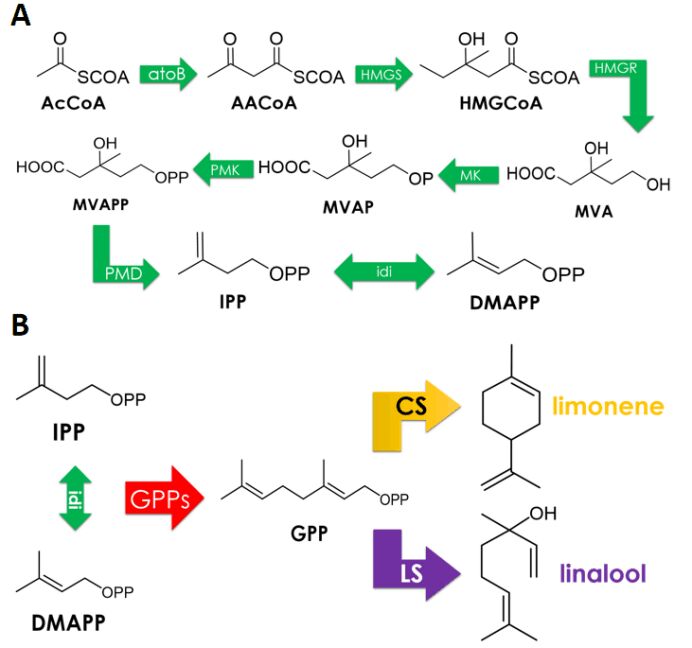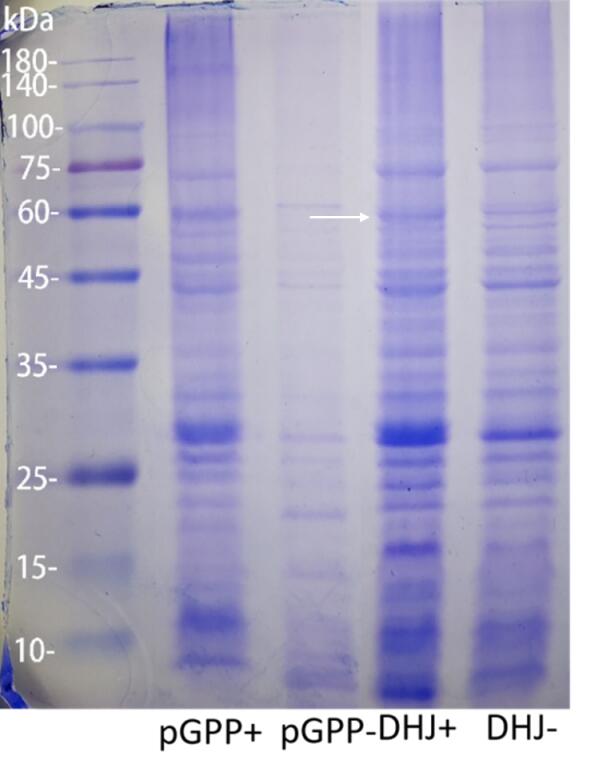Difference between revisions of "Part:BBa K3052004"
(→Background) |
|||
| (4 intermediate revisions by 2 users not shown) | |||
| Line 3: | Line 3: | ||
<partinfo>BBa_K3052004 short</partinfo> | <partinfo>BBa_K3052004 short</partinfo> | ||
| − | The linalool synthase is used to convert geranyl pyrophosphate (GPP) to linalool, which has aroma of lavendar. | + | The linalool synthase is used to convert geranyl pyrophosphate (GPP) to linalool, which has aroma of lavendar. This is a codon-optimized version based on E.coli. |
<!-- Add more about the biology of this part here | <!-- Add more about the biology of this part here | ||
| Line 22: | Line 22: | ||
===Background=== | ===Background=== | ||
| − | In our study, we aim to achieve limonene and linalool synthesis in <i>E.coli</i> DH5<i>α</i>. According to 2018 GreatBay_China team’s experience, no target product was detected using gas chromatography when carrying out shake-flask fermentation with this strain induced by 25uM IPTG for 24 hours due to the lack of endogenous MVA pathways wherein GPP is produced. Thus we decided to co-express an MVA pathway. 2018 GreatBay_China generously gave us one plasmid pJBEI6409, which contains a MVA pathway in addition to an GPPs-LS operon. We reconstructed this plasmid and get a plasmid only contains a MVA pathway. | + | In our study, we aim to achieve limonene and linalool synthesis in <i>E.coli</i> DH5<i>α</i>. According to 2018 GreatBay_China team’s experience, no target product was detected using gas chromatography when carrying out shake-flask fermentation with this strain induced by 25uM IPTG for 24 hours due to the lack of endogenous MVA pathways wherein GPP is produced. Thus we decided to co-express an MVA pathway. 2018 GreatBay_China generously gave us one plasmid pJBEI6409(Keasling et al., 2013), which contains a MVA pathway in addition to an GPPs-LS operon. We reconstructed this plasmid and get a plasmid only contains a MVA pathway. |
| Line 29: | Line 29: | ||
We have used MVA synthesis pathway which is common in plants. Since limonene and linalool have the same synthetic precursor GPP, we have divided the synthesis pathway into two parts: | We have used MVA synthesis pathway which is common in plants. Since limonene and linalool have the same synthetic precursor GPP, we have divided the synthesis pathway into two parts: | ||
| − | 1. (<partinfo> | + | 1. (<partinfo>BBa_K3052010</partinfo>) IPTG inducible precursor circuit which contains eight enzymes of MVA pathway enable conversion from AcCoA to GPP: atoB, HMGS, HMGR, MK, PMK, PMD, idi, trGPPs. |
| − | 2. (<partinfo> | + | 2. (<partinfo>BBa_K3052001</partinfo>, <partinfo>BBa_K3052004</partinfo>) two Production Circuits: limonene synthase or linalool synthase regulated by a ptrc promoter in <i>E. coli</i>. |
| + | Reference | ||
| + | [1]lonso-Gutierrez, J., Chan, R., Batth, T. S., Adams, P. D., Keasling, J. D., Petzold, C. J., & Lee, T. S. (2013). | ||
| + | Metabolic engineering of Escherichia coli for limonene and perillyl alcohol production. | ||
| + | Metabolic engineering, 19, 33-41. | ||
===Characterization=== | ===Characterization=== | ||
| Line 41: | Line 45: | ||
<div>[[File:T--XJTU-CHINA--DHJ-PCR.png |700px|thumb|center|<b>Figure 2:</b> Gel results of PCR amplification of CS ]]</div> | <div>[[File:T--XJTU-CHINA--DHJ-PCR.png |700px|thumb|center|<b>Figure 2:</b> Gel results of PCR amplification of CS ]]</div> | ||
| − | The expression of | + | The expression of and linalool synthases are under the regulation of Ptrc. RT-qPCR and SDS-PAGE were conducted to test its expression, as well as Gas Chromatography analysis was used to detect linalool yields. Click to see our protocol. |
| − | We measured the transcription level of CS and LSs of four different strains, E.coli harboring only pGPP vector, E.coli with dual | + | We measured the transcription level of CS and LSs of four different strains, E.coli harboring only pGPP vector, E.coli with dual plasmids pGPP+pDHJ (Stain B in Fig 3), pGPP+pLGF (Stain C in Fig 3), pGPP+pCS (Stain A in Fig 3),and relative mRNA levels compared with the blank strain only harboring pGPP are shown in Fig 4. |
<div>[[File:T--XJTU-CHINA--DM7.png |700px|thumb|center|<b>Figure 3:</b>RT-qPCR result of linalool synthase DHJ, LGF and limonene synthase CS]]</div> | <div>[[File:T--XJTU-CHINA--DM7.png |700px|thumb|center|<b>Figure 3:</b>RT-qPCR result of linalool synthase DHJ, LGF and limonene synthase CS]]</div> | ||
| Line 53: | Line 57: | ||
Both the results of above RT-qPCR and SDS-PAGE demonstrate the expression of the linalool synthase DHJ. | Both the results of above RT-qPCR and SDS-PAGE demonstrate the expression of the linalool synthase DHJ. | ||
| − | <div>[[File:T--XJTU-CHINA-- | + | <div>[[File:T--XJTU-CHINA--LSGC.png |700px|thumb|center|<b>Figure 5:</b>Comparison of linalool production of E. coli strain harboring LS gene with linalool standard, confirmed its production.]]</div> |
| − | GC analysis will confirm whether the expressed protein is functional. | + | GC analysis will confirm whether the expressed protein is functional. We expressed the linalool synthase with trc promoter in DH5α E. coli and lysed the cell culture, extracted with n-hexane, and the extraction was subjected to gas chromatography mass spectrometry.As shown in the figure below, a little bit of linalool can be detected with same retention time with standard. |
| − | + | All in all, the analysis of RT-qPCR, SDS-PAGE and GC-MS have demonstrated that the fragrance molecule linalool can be successfully synthetized by engineered E.coli with our selected enzymes. | |
| − | All in all, the | + | |
Latest revision as of 03:18, 22 October 2019
(S)-linalool synthase: DHJ
The linalool synthase is used to convert geranyl pyrophosphate (GPP) to linalool, which has aroma of lavendar. This is a codon-optimized version based on E.coli.
Sequence and Features
- 10INCOMPATIBLE WITH RFC[10]Illegal PstI site found at 490
Illegal PstI site found at 571
Illegal PstI site found at 994
Illegal PstI site found at 1060
Illegal PstI site found at 1150 - 12INCOMPATIBLE WITH RFC[12]Illegal PstI site found at 490
Illegal PstI site found at 571
Illegal PstI site found at 994
Illegal PstI site found at 1060
Illegal PstI site found at 1150 - 21COMPATIBLE WITH RFC[21]
- 23INCOMPATIBLE WITH RFC[23]Illegal PstI site found at 490
Illegal PstI site found at 571
Illegal PstI site found at 994
Illegal PstI site found at 1060
Illegal PstI site found at 1150 - 25INCOMPATIBLE WITH RFC[25]Illegal PstI site found at 490
Illegal PstI site found at 571
Illegal PstI site found at 994
Illegal PstI site found at 1060
Illegal PstI site found at 1150
Illegal NgoMIV site found at 21 - 1000COMPATIBLE WITH RFC[1000]
Characterization
Background
In our study, we aim to achieve limonene and linalool synthesis in E.coli DH5α. According to 2018 GreatBay_China team’s experience, no target product was detected using gas chromatography when carrying out shake-flask fermentation with this strain induced by 25uM IPTG for 24 hours due to the lack of endogenous MVA pathways wherein GPP is produced. Thus we decided to co-express an MVA pathway. 2018 GreatBay_China generously gave us one plasmid pJBEI6409(Keasling et al., 2013), which contains a MVA pathway in addition to an GPPs-LS operon. We reconstructed this plasmid and get a plasmid only contains a MVA pathway.
We have used MVA synthesis pathway which is common in plants. Since limonene and linalool have the same synthetic precursor GPP, we have divided the synthesis pathway into two parts:
1. (BBa_K3052010) IPTG inducible precursor circuit which contains eight enzymes of MVA pathway enable conversion from AcCoA to GPP: atoB, HMGS, HMGR, MK, PMK, PMD, idi, trGPPs.
2. (BBa_K3052001, BBa_K3052004) two Production Circuits: limonene synthase or linalool synthase regulated by a ptrc promoter in E. coli.
Reference [1]lonso-Gutierrez, J., Chan, R., Batth, T. S., Adams, P. D., Keasling, J. D., Petzold, C. J., & Lee, T. S. (2013). Metabolic engineering of Escherichia coli for limonene and perillyl alcohol production. Metabolic engineering, 19, 33-41.
Characterization
Ptrc and linalool synthase genes was obtained by PCR flanked two Type IIS sites BsaI and was used for Golden Gate Assembly to construct the expression vectors. The length of linalool synthase DHJ is 1632bp. Here is the gel results confirming success amplifications.
The expression of and linalool synthases are under the regulation of Ptrc. RT-qPCR and SDS-PAGE were conducted to test its expression, as well as Gas Chromatography analysis was used to detect linalool yields. Click to see our protocol. We measured the transcription level of CS and LSs of four different strains, E.coli harboring only pGPP vector, E.coli with dual plasmids pGPP+pDHJ (Stain B in Fig 3), pGPP+pLGF (Stain C in Fig 3), pGPP+pCS (Stain A in Fig 3),and relative mRNA levels compared with the blank strain only harboring pGPP are shown in Fig 4.
As shown in Fig 4, compared to blank strain, the relative mRNA level of three strains were much higher, which DHJ were most actively transcripted, and CS was relatively less, but all indicated the efficient transcription of these three genes in engineered E.coli. We also conducted SDS-PAGE of whole cell proteins to ensure their expression. As shown in Fig 6, compared to blank strain only with pGPP vector, CS protein was expressed but yields were not high, and because of the leaky expression, expression level with IPTG induction were just a little bit higher than the level without IPTG induction.
Both the results of above RT-qPCR and SDS-PAGE demonstrate the expression of the linalool synthase DHJ.
GC analysis will confirm whether the expressed protein is functional. We expressed the linalool synthase with trc promoter in DH5α E. coli and lysed the cell culture, extracted with n-hexane, and the extraction was subjected to gas chromatography mass spectrometry.As shown in the figure below, a little bit of linalool can be detected with same retention time with standard. All in all, the analysis of RT-qPCR, SDS-PAGE and GC-MS have demonstrated that the fragrance molecule linalool can be successfully synthetized by engineered E.coli with our selected enzymes.





